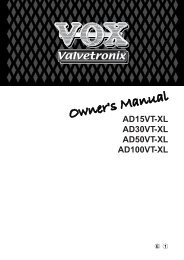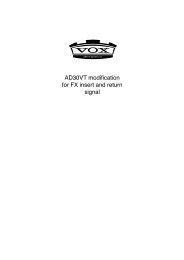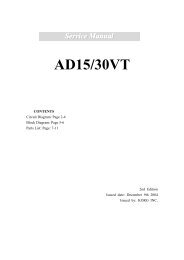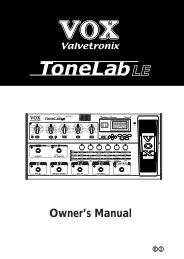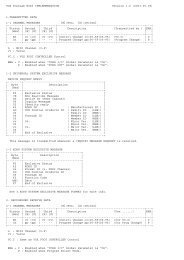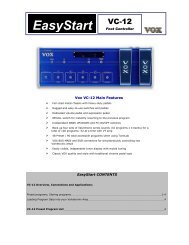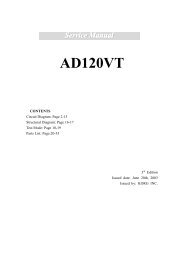ToneLab SE Owner's manual - Vox
ToneLab SE Owner's manual - Vox
ToneLab SE Owner's manual - Vox
Create successful ePaper yourself
Turn your PDF publications into a flip-book with our unique Google optimized e-Paper software.
• You can use the effect insert jacks to connect an external effect processor or<br />
stompbox.<br />
• With MIDI IN and OUT connectors, <strong>ToneLab</strong><strong>SE</strong> gives you plenty of potential for<br />
expanding your system.<br />
• <strong>ToneLab</strong><strong>SE</strong> Sound Editor is an editor/librarian software that lets you visually edit<br />
<strong>ToneLab</strong><strong>SE</strong>’s numerous parameters, and save and manage programs.<br />
To obtain the “<strong>ToneLab</strong><strong>SE</strong> Sound Editor,” please contact the VOX distributor in<br />
your country or download the latest version from:<br />
“http://www.voxamps.co.uk” or “http://www.valvetronix.com/”<br />
To find your local Distributor go to:<br />
“http://www.voxamps.co.uk/dealers/worldwid.htm”<br />
VALVE REACTOR TECHNOLOGY<br />
THE POWER (AMP) AND THE GLORY!<br />
Valve Reactor technology was first used on the critically acclaimed VOX<br />
AD60/120VT Valvetronix amps.<br />
The Valve Reactor circuitry in <strong>ToneLab</strong><strong>SE</strong> however has been tuned-up<br />
especially for live performance.<br />
Since conventional modeling effects for line recording are not used directly<br />
with a speaker, they do not include a power amp circuit, output transformer, or<br />
speaker. In other words, they only have a preamp circuit.<br />
A real valve amp sound, however, is produced not just by the preamp, but also by<br />
the tone and distortion of the power amp, and by the constant changes in impedance<br />
that are created by the power amp driving the speakers. <strong>ToneLab</strong><strong>SE</strong> contains<br />
an actual low-wattage valve power amp circuit, a virtual output transformer<br />
(patent applied for) that uses solid-state components to simulate an output transformer,<br />
and a dummy speaker circuit that simulates the varying impedance of a<br />
real speaker. This means that although it’s low-power, <strong>ToneLab</strong><strong>SE</strong> has the same<br />
circuit structure of an actual all-valve amp.<br />
While much of the tone creation and shaping carried out is done in the digital<br />
domain, its Valve Reactor power amp is 100% analogue. The resulting journey your<br />
guitar’s signal takes through the analogue world of the power stage plays a major<br />
role in providing the all-important feel and tone of the original amps we modelled.<br />
The Valve Reactor power stage is, to all intents and purposes, a bona fide valve<br />
(tube) push-pull power amplifier, but in miniature. It utilizes a 12AX7 (ECC83) valve<br />
(a dual triode device - meaning “two valves in one”) and is equipped with an output<br />
transformer, like a “real” valve amp.<br />
The power amp output of <strong>ToneLab</strong><strong>SE</strong>’s Valve Reactor is designed to “read” the constantly<br />
changing impedance curve of the dummy speaker circuit system and feed this<br />
information back to the virtual output transformer – just like real valve amplifiers do.<br />
This information permits the behavior of the valve stage of the amp to vary with the<br />
speaker load (impedance), which is another important part of “real world” valve tone.<br />
2




